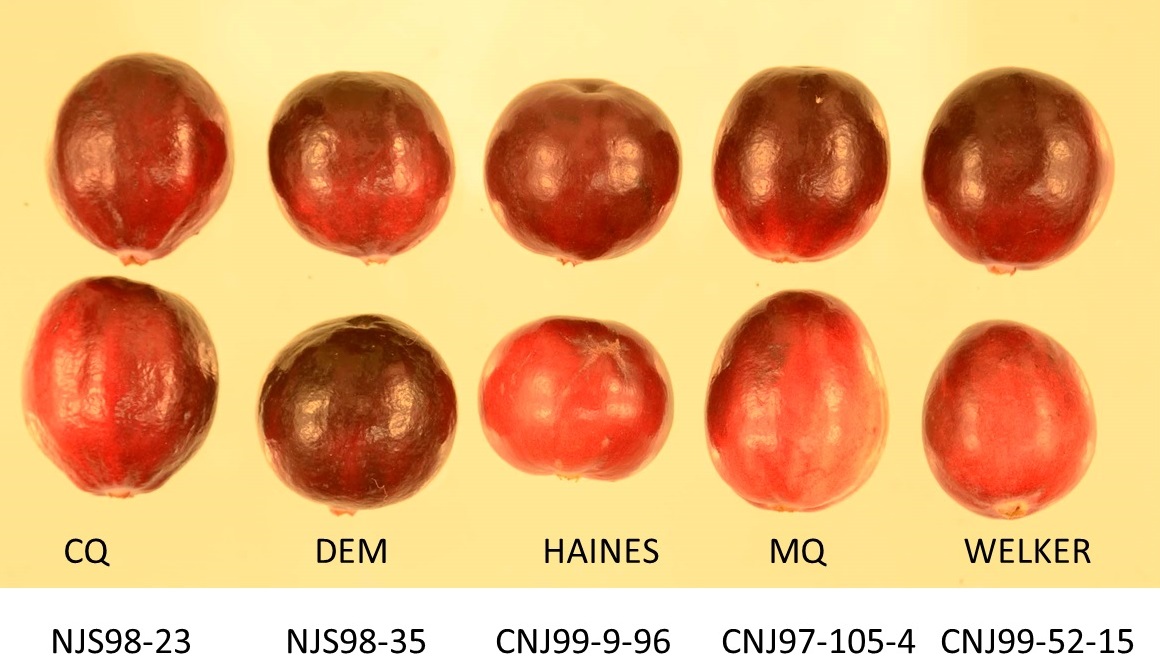CNJ99-9-96
| Denomination: | 'CNJ99-9-96' |
|---|---|
| Trade name: | Haines |
| Botanical Name: | Vaccinium macrocarpon |
| Applicant/Holder: |
Rutgers, The State University of New Jersey Old Queens, Somerset Street New Brunswick, New Jersey 08903 United States of America |
| Breeder: |
Nicholi Vorsa, Rutgers, The State University of New Jersey, Atco, United States of America Jennifer Johnson-Cicalese, Rutgers, The State University of New Jersey, Medford, United States of America |
| Agent in Canada: |
Cassan Maclean 190 O'Connor St., Suite 710 Ottawa, Ontario K2P 2R3 Canada Tel: 613-238-6404 ext. 240 |
| Application Date: | 2014-11-24 |
| Application Number: | 14-8499 |
| Grant of Rights Date: | 2021-11-23 |
| Certificate Number: | 6508 |
| Exemption from compulsory licensing: | Yes |
| Expiry date for exemption from compulsory licensing: | 2023-11-23 |
| Grant of Rights Termination Date: | 2041-11-23 |
Variety Description
Varieties used for comparison: 'NJS98-35' (Demoranville), 'NJS98-23' (Crimson Queen), 'CNJ97-105-4' (Mullica Queen) and 'CNJ99-52-15' (Welker)
Summary: The plants of 'CNJ99-9-96' flower late in the season whereas the plants of 'NJS98-23' and 'CNJ97-105-4' flower mid-season and the plants of 'NJS98-35' and 'CNJ99-52-15' flower early in the season . The plants of 'CNJ99-9-96' reach harvest maturity at mid-season whereas the plants of 'NJS98-35', 'NJS98-23' and 'CNJ99-52-15' reach maturity early in the season. The berry of 'CNJ99-9-96' is shorter than that of all the reference varieties. The berry of 'CNJ99-9-96' has a low length to width ratio whereas the berry of both 'NJS98-23' and 'CNJ97-105-4' have medium length to width ratio and the berry of 'NJS98-35' has a medium to high length to width ratio. The surface of the berries of 'CNJ99-9-96' is even (smooth) whereas the surface of the berries for 'NJS98-23' is uneven in an irregular pattern. With the bloom removed, the skin of the berry of 'CNJ99-9-96' is medium red whereas the skin colour for 'NJS98-35' and 'CNJ99-52-15' is purple red. The skin of the berry of 'CNJ99-9-96' has a uniform colour whereas that of 'CNJ97-105-4' is not uniform.
Description:
YOUNG PLANT: medium to dense
PLANT: late season flowering, mid-season harvest maturity
BERRY: oblate or rectangular/block shape, medium size, low length to width ratio, even fruit surface, medium red skin with bloom removed, uniform colour
Origin & Breeding History: 'CNJ99-9-96' originated from the cross made in 1999 at Rutgers University in Chatsworth, New Jersey, USA between 'NJ S 98-23' , as the female parent, and '#35' , as the male parent. A single plant was initially selected from 138 progenies for its yield potential, time of fruit ripening, berry size, shape and colour. In 2007, 'CNJ99-9-96' was selected and planted in replicated variety trials in Oregon, Washington and Wisconsin, USA for additional evaluation. Final advancement of 'CNJ99-9-96' was based on yield and time of fruit ripening.
Tests & Trials: The comparative trial for 'CNJ99-9-96' was conducted during the 2019 growing season at the British Columbia Cranberry Growers Association Research Farm in Delta, British Columbia. In 2017, the trial was planted with 8 plots of 6 plants per plot of each variety for a total of 48 plants per variety. Plots were arranged in an RCB Design, with 8 replications. At the time of planting, there was a spacing of approximately 0.9 metres between plots and a spacing of approximately 0.3 metres between plants. Observations were taken on 20 plants or parts of plants of each variety. Measurements were taken on a minimum of 58 berries of each variety.
Comparison table for 'CNJ99-9-96' with reference varieties 'NJS98-35', 'NJS98-23', 'CNJ97-105-4' and 'CNJ99-52-15'
Berry length (mm)
| 'CNJ99-9-96' | 'NJS98-35' | 'NJS98-23' | 'CNJ97-105-4' | 'CNJ99-52-15' | |
|---|---|---|---|---|---|
| mean | 15.1 | 19.2 | 17.7 | 18.2 | 17.8 |
| std. deviation | 1.8 | 2.0 | 2.5 | 2.0 | 2.1 |
Click on image for larger view

Cranberry: 'CNJ99-9-96' (centre) with reference varieties 'NJS98-35' (second from left), 'NJS98-23' (furthest left) and 'CNJ97-105-4' (second from right)
- Date modified: